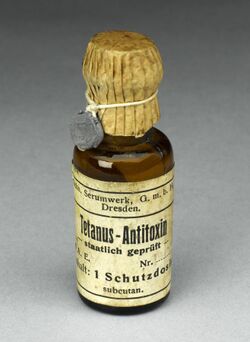Medicine:Anti-tetanus immunoglobulin
 A vintage single-dose bottle of tetanus antitoxin manufactured by Sächsisches Serumwerk Dresden (now GlaxoSmithKline) | |
| Clinical data | |
|---|---|
| Trade names | HyperTET S/D, others |
| Other names | tetanus immune globulin, tetanus antitoxin |
| AHFS/Drugs.com | Monograph |
| Pregnancy category |
|
| Routes of administration | IM |
| Identifiers | |
| CAS Number | |
| ChemSpider |
|
Anti-tetanus immunoglobulin, also known as tetanus immune globulin (TIG) and tetanus antitoxin, is a medication made up of antibodies against the tetanus toxin.[1] It is used to prevent tetanus in those who have a wound that is at high risk, have not been fully vaccinated with tetanus toxoid, or have HIV/AIDS.[1][2] It is used to treat tetanus along with antibiotics and muscle relaxants.[1] It is given by injection into a muscle.[1] Part of the dose is injected at the site of the wound.[2]
Common side effects include pain at the site of injection and fever.[1] Allergic reactions including anaphylaxis may rarely occur.[1] There is also a very low risk of the spread of infections such as viral hepatitis and HIV/AIDS with the human version.[1] Use during pregnancy and lactation is acceptable.[3][4] It is made from either human or horse blood plasma.[1][5]
The immunoglobulin is categorized as immunoglobulin G (IgG).[4] Since the tetanus toxin permanently binds to human tissues, only unbounded molecules can be neutralized by the immunoglobulin.[2]
Use of the horse version became common in the 1910s, while the human version came into frequent use in the 1960s.[6] It is on the World Health Organization's List of Essential Medicines.[7][8] The human version may be unavailable in the developing world.[5] The horse version is not typically used in the developed world due to the risk of serum sickness.[9]
References
- ↑ 1.0 1.1 1.2 1.3 1.4 1.5 1.6 1.7 "Tetanus Immune Globulin". The American Society of Health-System Pharmacists. Archived from the original on 9 January 2017. https://web.archive.org/web/20170109023108/https://www.drugs.com/monograph/tetanus-immune-globulin.html. Retrieved 8 January 2017.
- ↑ 2.0 2.1 2.2 "Tetanus Prophylaxis", StatPearls (Treasure Island (FL): StatPearls Publishing), 2022, PMID 32644434, http://www.ncbi.nlm.nih.gov/books/NBK559008/, retrieved 2022-08-08
- ↑ "Tetanus immune globulin Use During Pregnancy | Drugs.com". Archived from the original on 9 January 2017. https://web.archive.org/web/20170109022333/https://www.drugs.com/pregnancy/tetanus-immune-globulin.html. Retrieved 8 January 2017.
- ↑ 4.0 4.1 "Tetanus Immune Globulin (Human)", Drugs and Lactation Database (LactMed) (Bethesda (MD): National Library of Medicine (US)), 2006, PMID 30000001, http://www.ncbi.nlm.nih.gov/books/NBK500942/, retrieved 2022-08-08
- ↑ 5.0 5.1 (in en) International Encyclopedia of Public Health (2 ed.). Academic Press. 2016. p. 161. ISBN 9780128037089. https://books.google.com/books?id=WAnpCgAAQBAJ&pg=RA6-PA161.
- ↑ (in en) Vaccines. Elsevier Health Sciences. 2012. pp. 103, 757. ISBN 978-1455700905. https://books.google.com/books?id=hoigDQ6vdDQC&pg=PA103.
- ↑ World Health Organization model list of essential medicines: 21st list 2019. Geneva: World Health Organization. 2019. WHO/MVP/EMP/IAU/2019.06. License: CC BY-NC-SA 3.0 IGO.
- ↑ World Health Organization model list of essential medicines: 22nd list (2021). Geneva: World Health Organization. 2021. WHO/MHP/HPS/EML/2021.02.
- ↑ (in en) Harrison's Principles of Internal Medicine, 17th Edition. McGraw Hill Professional. 2008. p. 773. ISBN 9780071641142. https://books.google.com/books?id=_YqKAwAAQBAJ.
 |

